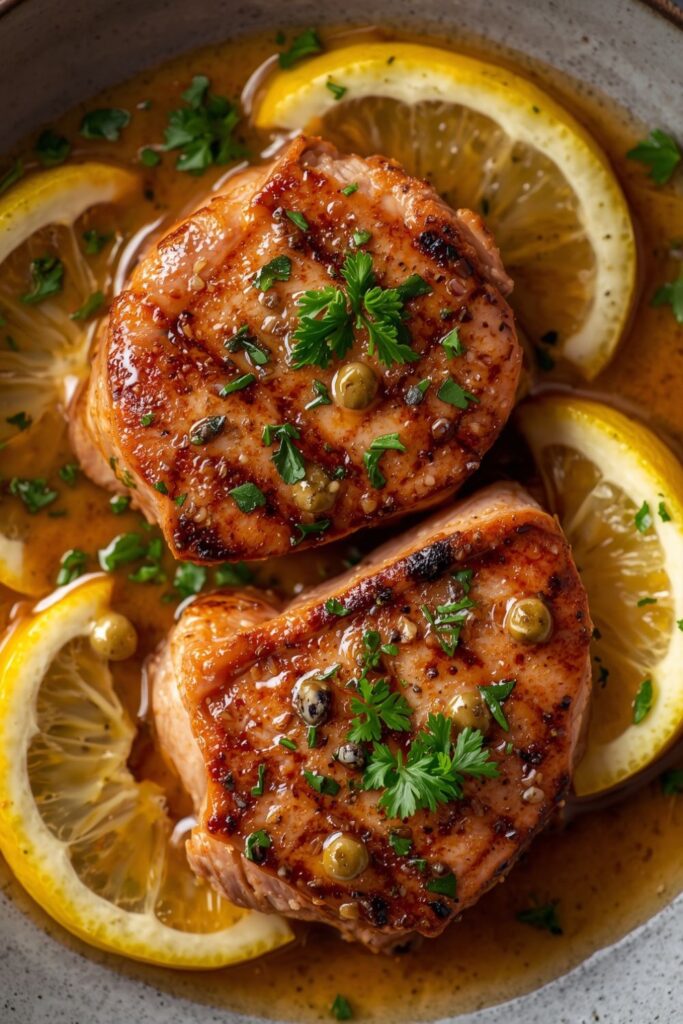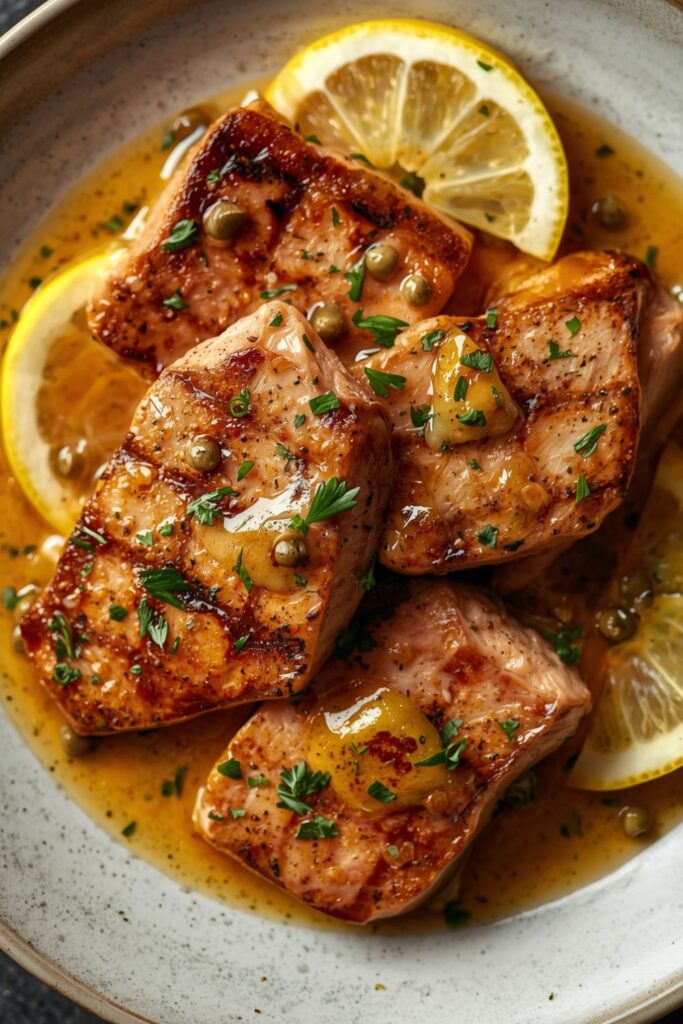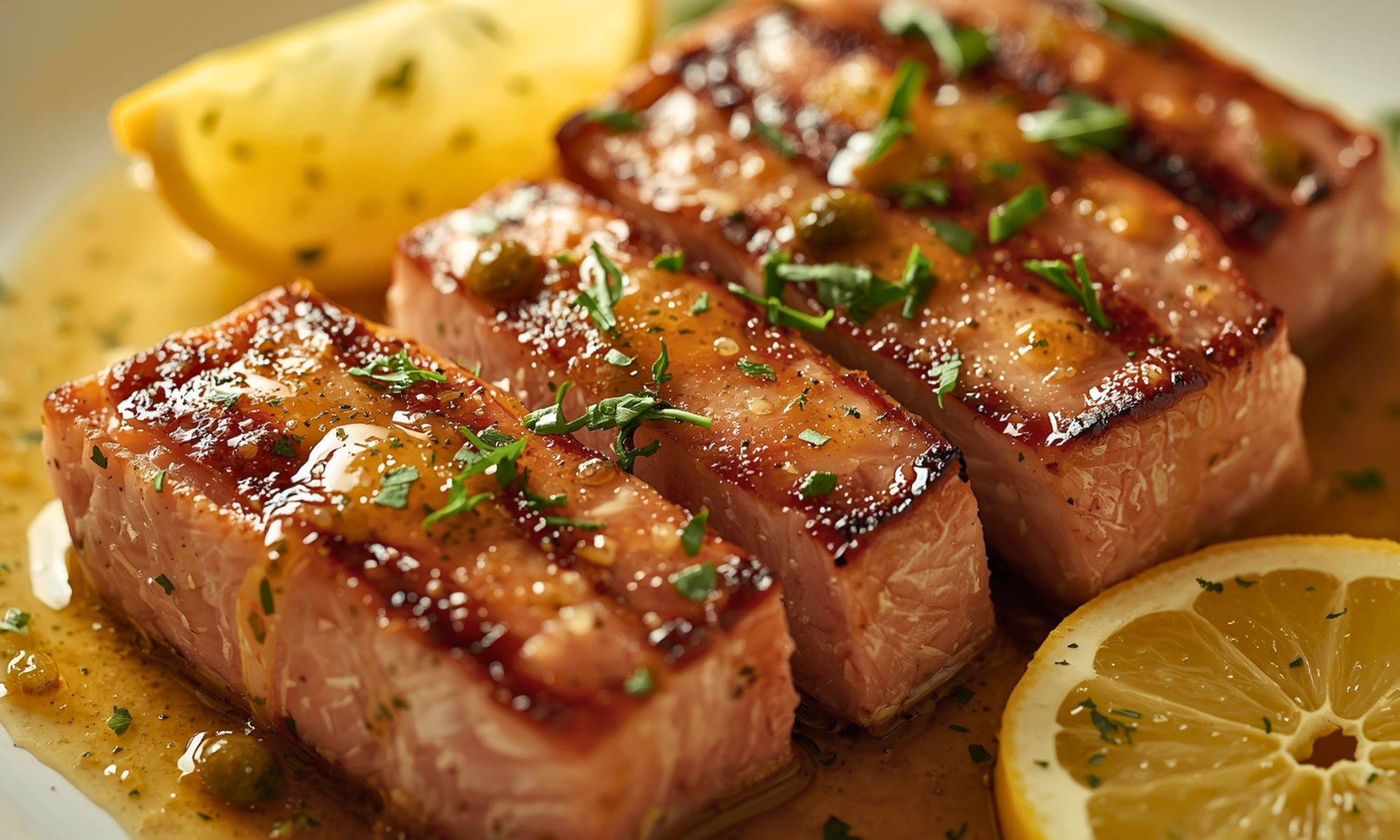Imagine the soundtrack of your kitchen: butter hitting a hot pan with that first loud sizzle, the snap of garlic edges crisping in oil, and a burst of lemon that cuts through the air like a clean, bright chord. That’s the overture to seared tuna steaks with lemon caper and parsley butter, a dish that doesn’t tiptoe in; it makes an entrance.
This recipe was born in one of those unscripted nights when I had no grand plan, just a craving and two tuna steaks daring me to do better than boring. I threw in capers for their salty punch, a fistful of parsley for freshness, and let the sauce write its own melody around the sear. Nothing fussy, nothing forced, just a dish that feels alive, layered, and ridiculously satisfying.
What you end up with isn’t just food, it’s energy on a plate. Crisp, golden edges meet a tender, ruby pink center, wrapped in lemony butter that refuses to play background music. Quick enough for a Tuesday, bold enough for a Saturday, and so good you’ll wonder why you ever settled for bland.
Stick around, I’ll show you how to nail the sear, balance the flavors, and make seared tuna steaks with lemon caper and parsley butter a dish you’ll come back to whenever you want dinner to sing.
Why Seared Tuna Steaks with Lemon Caper and Parsley Butter Deserves Your Attention

Here’s what makes this dish absolutely worth your time: it’s restaurant quality food that takes maybe fifteen minutes start to finish. The compound butter can be made days ahead, and once you nail the searing technique, you’ll have dinner party guests thinking you’ve been hiding your culinary superpowers.
The magic happens in layers. First, you’ve got that beautiful contrast between the caramelized exterior and the cool, silky center. Then comes the compound butter, tangy capers, bright lemon zest, and fresh parsley that cuts through the richness perfectly.
But here’s the real game changer: this technique works with any thick fish steak. Swordfish, salmon, even thick halibut. Once you understand the principles behind perfect seared tuna steaks with lemon caper and parsley butter, you’re gonna find yourself using this method all the time.
Essential Ingredients for Perfect Seared Tuna
For the Tuna:
- 4 thick tuna steaks (6-8 oz each, 1½ inches thick minimum)
- 2 tablespoons high heat oil (grapeseed or avocado work perfectly)
- Salt and freshly cracked black pepper
- Optional: sesame seeds for coating
For the Lemon Caper Parsley Butter:
- 8 tablespoons unsalted butter, room temperature
- 2 tablespoons capers, drained and roughly chopped
- 3 tablespoons fresh parsley, finely minced
- Zest of 2 lemons (save juice for serving)
- 2 cloves garlic, microplaned
- ½ teaspoon red pepper flakes
- Sea salt to taste
Smart Ingredient Swaps That Actually Work
Can’t find sushi grade tuna? Look, I get it, not everyone lives near a great fish market. Your regular grocery store tuna will work, just make sure it’s the freshest they’ve got and cook it longer if you’re nervous. The compound butter will still make it sing.
No capers on hand? Green olives chopped fine deliver that same briny punch. Anchovies work too if you’re feeling adventurous, just use half the amount since they pack more intensity.
Fresh herbs making your wallet cry? Here’s a secret most chefs won’t share: quality dried herbs absolutely work in compound butter. Use about a third of the amount, and add fresh lemon juice to wake them up.
For the oil, anything with high smoke point works perfectly. Even regular canola does the job, though grapeseed gives you that slightly nutty flavor that plays beautifully with tuna.
Master the Step by Step Technique for Seared Tuna Steaks

Step 1: Create Your Compound Butter Foundation
This saves your life during dinner prep. In a medium bowl, cream that room temperature butter until fluffy. Don’t skip this step, air makes everything taste lighter and more luxurious.
Fold in your chopped capers, minced parsley, lemon zest, garlic, and red pepper flakes. Taste it. Need more salt? Add it. Want more brightness? Hit it with tiny lemon juice squeeze.
Here’s the pro move: transfer this onto plastic wrap, roll it into a log, and refrigerate it. It keeps for a week, and you can slice medallions whenever needed. I make double batches because this butter transforms everything from grilled vegetables to crusty bread.
Step 2: Prep Your Tuna Like a Professional
Take those steaks out twenty minutes before cooking. Cold fish hitting hot pan equals uneven cooking, and we’re not having that drama tonight.
Pat them completely dry with paper towels. I mean completely, any surface moisture steams instead of sears, and we want that gorgeous golden crust that makes seared tuna steaks with lemon caper and parsley butter so irresistible.
Season generously with salt and pepper. Don’t be shy here. Salt helps create that crust we’re after, plus it draws out enough moisture to concentrate flavors beautifully.
Step 3: Get That Pan Screaming Hot
Use a heavy bottomed pan, cast iron, carbon steel, or good stainless steel skillet. None of that nonstick nonsense for this technique. You want something that holds heat and delivers real browning power.
Heat it over medium high until properly hot. How do you know? Flick a water drop onto the surface. It should sizzle and evaporate immediately, not dance around confused.
Add your oil and swirl it around. The oil should shimmer but not smoke. If it’s smoking, back off the heat slightly.
Step 4: Execute the Perfect Sear
Lay those tuna steaks away from you (prevents oil splatter hitting your face, learned that the hard way). Don’t move them. Don’t peek. Don’t even think about it.
For 1½-inch steaks, you want 90 seconds to 2 minutes per side for perfect rare center. The fish releases easily from pan when ready. If it’s sticking, it’s not done searing yet.
Flip once, just once, and sear the other side. Here’s where most people mess up: they keep flipping because they’re nervous. Trust the process completely.
Step 5: Let It Rest for Perfect Results
Pull those beauties off heat and let them rest 3-4 minutes. This isn’t optional, residual heat finishes cooking gently while juices redistribute throughout the fish.
While they’re resting, slice your compound butter into thick medallions. The contrast of cold, herby butter melting over warm fish creates pure magic in every bite.
The Science Behind Perfectly Seared Tuna Steaks with Lemon Caper and Parsley Butter
Here’s what’s actually happening in that hot pan: the Maillard reaction. It’s the same process that browns a good steak or caramelizes onions perfectly. High heat causes proteins and sugars to react, creating hundreds of new flavor compounds.
With tuna, you want just enough heat penetration to create that golden crust while keeping the center cool and silky. The thick cut is crucial, thin steaks cook through too fast, and you lose that beautiful texture contrast that makes this dish special.
That resting period isn’t just about temperature management. Fish proteins continue firming up even after removing heat, so that brief pause lets everything settle into perfect texture.
The compound butter technique comes from classical French cooking, where they call it “beurre composé.” It’s essentially sauce and garnish rolled into one, and the cold butter slowly melting creates gorgeous glossy finish that coats fish perfectly.
Presentation Tips for Restaurant Quality Results
Plating seared tuna isn’t rocket science, but few tricks make all the difference. Warm your plates first, just run them under hot water and dry them off. Cold plates cool down food too fast.
Slice the tuna against grain into thick medallions, about three quarter inch pieces show off that perfect pink center beautifully. Fan them slightly on plate so each piece gets its own moment to shine.
Drop those compound butter medallions right on top while fish is still warm. Watch it slowly melt and pool around the base, that’s your sauce right there, creating restaurant worthy presentation.
A squeeze of fresh lemon juice right before serving brightens everything up perfectly. Don’t skip this step. The acid cuts through richness and makes all those flavors pop dramatically.
Wine Pairings and Side Dishes
For wine pairings, think crisp and clean options. A good Sancerre or unoaked Chardonnay won’t compete with the fish’s delicate flavors. If you’re feeling fancy, a light Pinot Noir works beautifully too.
Side dish wise, keep it simple and complementary. Roasted asparagus, light salad with citrus vinaigrette, or even just good crusty bread to soak up that compound butter sauce works perfectly.
Pro Tips for Mastering Seared Tuna at Home
The biggest mistake people make with this dish? Overthinking every single step. This isn’t about perfect technique, it’s about understanding your ingredients and trusting the process completely.
Buy the best tuna you can afford, but don’t stress if it’s not sushi grade perfection. That compound butter elevates whatever you’re working with into something truly spectacular.
Practice the timing once, and you’ll have it down forever. Every tuna steak is slightly different, so use visual cues more than strict timing. When that first side releases easily from pan, it’s ready to flip.
Temperature matters more than most people realize with this technique. If your pan’s not hot enough, you’ll get gray, steamed fish instead of that gorgeous golden sear. If it’s too hot, the outside burns before inside warms up.
Advanced Variations Worth Trying
Once you’ve mastered the basic seared tuna steaks with lemon caper and parsley butter technique, try these sophisticated variations:
Asian Inspired Version: Add sesame oil to your compound butter with minced ginger and a touch of soy sauce. Coat the tuna with sesame seeds before searing.
Mediterranean Twist: Include sun dried tomatoes and fresh basil in your compound butter. Serve over arugula with balsamic drizzle.
Spicy Heat Option: Add minced jalapeño and extra red pepper flakes to your butter. Finish with lime instead of lemon for bright contrast.
Make extra compound butter every single time. Seriously. You’ll find yourself putting it on everything from grilled chicken to roasted vegetables. It keeps well in freezer too, just slice off what you need.
Troubleshooting Common Seared Tuna Mistakes

Problem: Tuna sticks to the pan every time. Solution: Your pan isn’t hot enough, or you’re flipping too early. The fish releases naturally when properly seared. Give it another 30 seconds.
Problem: Outside burns before inside warms up. Solution: Lower your heat slightly. Medium high works better than maximum heat for thick steaks like these.
Problem: Center stays too cold for your taste. Solution: Let it rest longer, or sear for additional 30 seconds per side. The compound butter will still taste amazing.
Problem: Compound butter breaks or separates. Solution: Your butter was too cold or hot. Room temperature butter creams perfectly and holds together beautifully.
The beauty of seared tuna steaks with lemon caper and parsley butter lies in how it rewards confidence over perfection. Once you nail that first attempt, you’ll understand why this technique has been making people feel like kitchen heroes for generations.
Frequently Asked Questions
How do I know if my tuna is fresh enough for rare cooking?
Look for bright, deep red color with no brown spots or fishy smell whatsoever. Fresh tuna should smell like ocean, not “fishy.” If you’re unsure about eating it rare, cook it longer, the compound butter still makes it delicious.
Can I make the compound butter ahead of time?
Absolutely, and you should make it ahead. It keeps in fridge up to a week and freezes beautifully for months. I always make double batches because it’s perfect on grilled vegetables, steaks, and crusty bread too.
What if I don’t have a cast iron pan?
Any heavy bottomed pan that holds heat well works perfectly. Stainless steel is fine, just make sure it gets properly hot before adding oil. Avoid nonstick pans, they don’t get hot enough for proper sear.
My tuna always seems to stick to the pan. What am I doing wrong?
Either your pan isn’t hot enough, or you’re trying to flip too early. The fish releases naturally when properly seared. If it’s sticking, give it another 30 seconds and try again.
Can I use frozen tuna steaks for this recipe?
Fresh is always better, but properly thawed frozen tuna works acceptably. Just make sure it’s completely thawed and patted absolutely dry. The texture won’t be quite as silky, but flavors will still be fantastic with that compound butter.

Swiftly Captions by Tina Smith — Quick, flavorful food recipes made simple, bringing fresh inspiration to your kitchen every day






